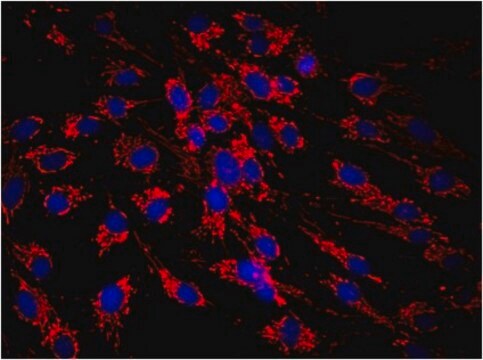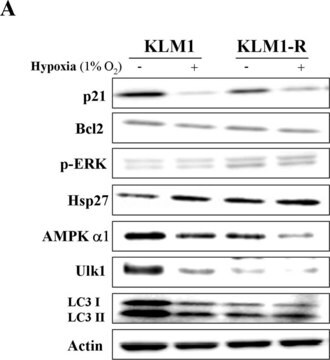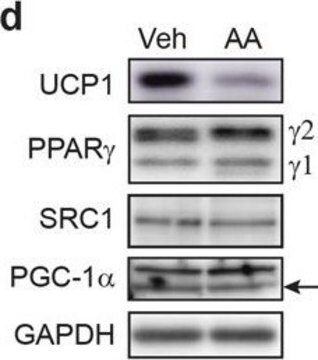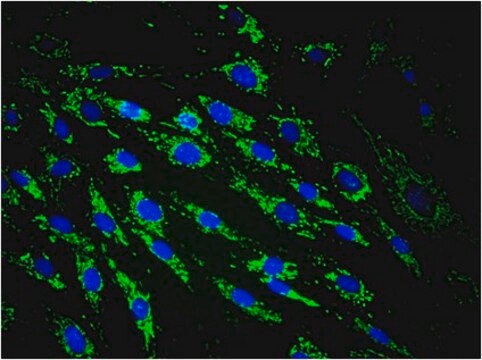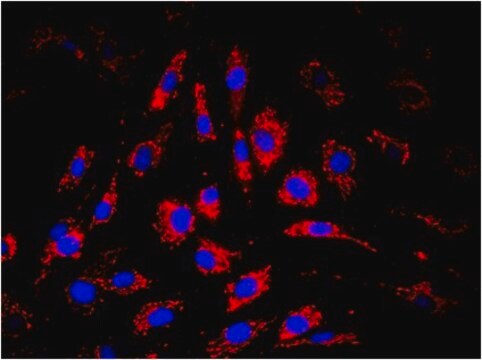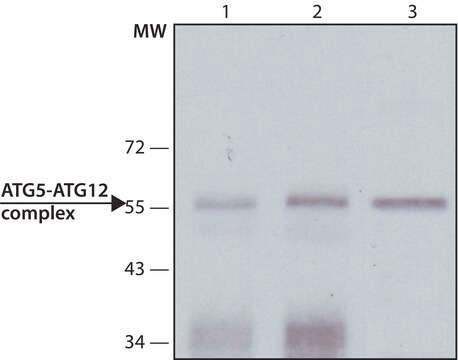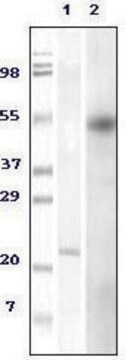MAB1273
Anti-Mitochondria Antibody, surface of intact mitochondria, clone 113-1
clone 113-1, Chemicon®, from mouse
Synonim(y):
Mitochondrial antibody
About This Item
Polecane produkty
pochodzenie biologiczne
mouse
Poziom jakości
forma przeciwciała
purified immunoglobulin
rodzaj przeciwciała
primary antibodies
klon
113-1, monoclonal
reaktywność gatunkowa
human
spodziewany brak reakcji z
mouse, rat
producent / nazwa handlowa
Chemicon®
metody
immunofluorescence: suitable
immunohistochemistry (formalin-fixed, paraffin-embedded sections): suitable
immunoprecipitation (IP): suitable
moc wejściowa
sample type neural stem cell(s)
izotyp
IgG1
Warunki transportu
dry ice
docelowa modyfikacja potranslacyjna
unmodified
Opis ogólny
Specyficzność
MAB1273 recognizes a 65 kD protein by immunoprecipitation. Antibody produces the stringy, "spaghetti-like" staining patten in the cytoplasm of human cells.
Immunogen
Zastosowanie
1:100 dilutoin from a previous lot was used. Works best with organic fixatives (acetone, methanol, etc). 2% PFA for 10-15 min can be used but stronger use of formalin or 4% PFA limits staining.
The antibody has been used to isolate intact mitochondria from freeze/thaw lysates of living cells via conjugation to magnetic beads {http://www.dynalbiotech.com}.
Immunohistochemistry in paraffin embedded tissues:
Requires citric acid/microwave antigen retrieval; enhanced ABC or amplified detection systems recommended.
Optimal Staining With EDTA Buffer, pH 8.0, Epitope Retrieval: Heart Ventricle Epithelium
The antibody has been used to isolate intact mitochondria from freeze/thaw lysates of living cells via conjugation to magnetic beads {http://www.dynalbiotech.com}.
Indirect immunofluorescence:
1:10-1:50 dilution from a previous lot was used, 30 - 100 μL per slide well.
MAB1273 recognizes a 65 kD protein by immunoprecipitation.
Optimal working dilutions and protocols must be determined by the end user.
Jakość
Immunohistochemistry(paraffin) Analysis:
Mitochondria (cat. # MAB1273) staining on heart ventricle cells. Tissue pretreated with EDTA, pH 8.0This lot of antibody was diluted to 1:80, using IHC-Select Detection with HRP-DAB. Immunoreactivity is seeing the circular-granular layer surrounding the nucleus of the cells.
Optimal Staining With EDTA Buffer, pH 8.0, Epitope Retrieval: Heart Ventricle Epithelium
Opis wartości docelowych
Postać fizyczna
Przechowywanie i stabilność
Komentarz do analizy
COS7 cells.
Inne uwagi
Informacje prawne
Nie możesz znaleźć właściwego produktu?
Wypróbuj nasz Narzędzie selektora produktów.
Kod klasy składowania
12 - Non Combustible Liquids
Klasa zagrożenia wodnego (WGK)
WGK 2
Temperatura zapłonu (°F)
Not applicable
Temperatura zapłonu (°C)
Not applicable
Certyfikaty analizy (CoA)
Poszukaj Certyfikaty analizy (CoA), wpisując numer partii/serii produktów. Numery serii i partii można znaleźć na etykiecie produktu po słowach „seria” lub „partia”.
Masz już ten produkt?
Dokumenty związane z niedawno zakupionymi produktami zostały zamieszczone w Bibliotece dokumentów.
Nasz zespół naukowców ma doświadczenie we wszystkich obszarach badań, w tym w naukach przyrodniczych, materiałoznawstwie, syntezie chemicznej, chromatografii, analityce i wielu innych dziedzinach.
Skontaktuj się z zespołem ds. pomocy technicznej